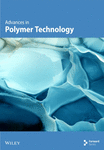Enhancement of mixing performance of single-screw extrusion processes via chaotic flows: Part I. Basic concepts and experimental study
Abstract
As far as the mixing performance in single-screw extrusion processes is concerned, it is well known that the deformation measure or stretching which materials undergo due to the regular flows inside a conventional screw channel increases linearly with the extruder channel length. In general, the chaotic mixing is far superior to the regular mixing. Therefore, it would be fascinating if one could make the chaotic mixing possible in single-screw extruders with a special, and yet easily manufacturable screw without sacrificing the pumping performance of single-screw extruders. With this purpose in mind, we have developed a new screw (termed “Chaos Screw”) for the single-screw extrusion process to enhance the mixing performance via the chaotic flows. The main idea of the Chaos Screw design lies in the spatially periodic barriers inserted in the channel to break closed streamlines in regular flows, which induces the chaotic mixing. The present article describes the basic mechanism of the chaotic mixing in a single-screw extruder and presents experimental evidence of the chaotic mixing using the Chaos Screw. Experimental mixing patterns due to the chaotic flow clearly indicate that the Chaos Screw drastically enhances the mixing performance in a single-screw extruder. It may be mentioned that the accompanying article, Part II, presents numerical investigation which shows that the chaotic mixing was successfully predicted by numerical simulations. © 1996 John Wiley & Sons, Inc.




